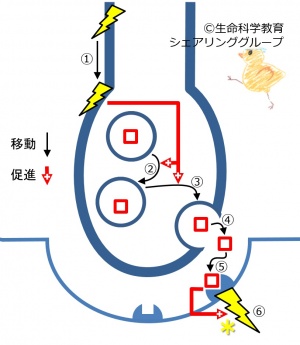「Nerv06/introduction/mechanism of synaptic transmission」の版間の差分
Soichi.Nakatake (トーク | 投稿記録) 編集の要約なし |
編集の要約なし |
||
| (2人の利用者による、間の16版が非表示) | |||
| 1行目: | 1行目: | ||
{{Point| | {{Point|The synaptic transmitter connects to the receptors on the post-synaptic membrane and generates an action potential}} | ||
[[file:03847.jpg|300px|left]] synaptic transmission is a chemical process. | |||
When an action potential 1. reaches the nerve ending of the pre-synaptic neuron, the synaptic vesicle 2. moves towards the pre-synaptic membrane and then 3. fuses with the pre-synaptic membrane. With this movement, 4. the synaptic transmitter is released, and then 5. connects to the receptor on the post-synaptic membrane. This causes the post-synaptic membrane to depolarize and an 6. action potential is generated. | |||
{{QuizTitle}} | |||
<GIFT> | <GIFT> | ||
//LEVEL:2 | //LEVEL:2 | ||
//RAND | //RAND | ||
The process of synaptic transmission is mainly {~electric~=chemical} | |||
//LEVEL:3 | //LEVEL:3 | ||
//RAND | //RAND | ||
The synaptic transmitter is released and then connects with the {~ion channels~=receptors} on the post-synaptic membrane. | |||
//LEVEL:2 | //LEVEL:2 | ||
//RAND | //RAND | ||
The synaptic transmitter connects to the receptor on the {~pre-synaptic~=post-synaptic} membrane. | |||
//LEVEL:3 | //LEVEL:3 | ||
//RAND | //RAND | ||
The synaptic transmitter is released from the {=pre-synaptic~post-synaptic} membrane. | |||
//LEVEL:3 | //LEVEL:3 | ||
//RAND | //RAND | ||
The synaptic transmitters are stored in the {~pre-synaptic membrane~post-synaptic membrane~synaptic cleft~=synaptic vesicle}. | |||
</GIFT> | </GIFT> | ||
2016年4月25日 (月) 00:08時点における最新版
| The synaptic transmitter connects to the receptors on the post-synaptic membrane and generates an action potential |
synaptic transmission is a chemical process.
When an action potential 1. reaches the nerve ending of the pre-synaptic neuron, the synaptic vesicle 2. moves towards the pre-synaptic membrane and then 3. fuses with the pre-synaptic membrane. With this movement, 4. the synaptic transmitter is released, and then 5. connects to the receptor on the post-synaptic membrane. This causes the post-synaptic membrane to depolarize and an 6. action potential is generated.
Challenge Quiz
The process of synaptic transmission is mainly electric chemical
The synaptic transmitter is released and then connects with the ion channels receptors on the post-synaptic membrane.
The synaptic transmitter connects to the receptor on the pre-synaptic post-synaptic membrane.
The synaptic transmitter is released from the pre-synaptic post-synaptic membrane.
The synaptic transmitters are stored in the pre-synaptic membrane post-synaptic membrane synaptic cleft synaptic vesicle .

